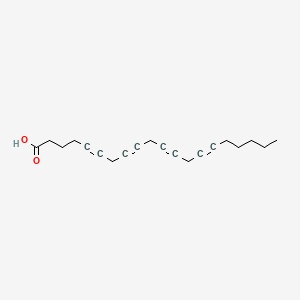| Cominacini L et al. |
Mechanisms involved in the in vitro modification of low density lipoprotein by human umbilical vein endothelial cells and copper ions. |
1996 |
J Lipid Mediat Cell Signal |
pmid:8821808
|
| Villarroel A and Schwarz TL |
Inhibition of the Kv4 (Shal) family of transient K+ currents by arachidonic acid. |
1996 |
J. Neurosci. |
pmid:8558229
|
| Villarroel A and Schwarz TL |
Inhibition of the Kv4 (Shal) family of transient K+ currents by arachidonic acid. |
1996 |
J. Neurosci. |
pmid:8786428
|
| Nishio H et al. |
Ca(2+)-independent fusion of synaptic vesicles with phospholipase A2-treated presynaptic membranes in vitro. |
1996 |
Biochem. J. |
pmid:8836147
|
| Roudbaraki MM et al. |
Arachidonic acid-induced hormone release in somatotropes: involvement of calcium. |
1996 |
Neuroendocrinology |
pmid:8677013
|
| Long SD and Pekala PH |
Lipid mediators of insulin resistance: ceramide signalling down-regulates GLUT4 gene transcription in 3T3-L1 adipocytes. |
1996 |
Biochem. J. |
pmid:8870666
|
| Watkins PA et al. |
Phytanic acid activation in rat liver peroxisomes is catalyzed by long-chain acyl-CoA synthetase. |
1996 |
J. Lipid Res. |
pmid:8978480
|
| Nagao T et al. |
Ca(2+)-independent fusion of secretory granules with phospholipase A2-treated plasma membranes in vitro. |
1995 |
Biochem. J. |
pmid:7537492
|
| Wu Z et al. |
Conditional ectopic expression of C/EBP beta in NIH-3T3 cells induces PPAR gamma and stimulates adipogenesis. |
1995 |
Genes Dev. |
pmid:7557387
|
| Vu-Dac N et al. |
Fibrates increase human apolipoprotein A-II expression through activation of the peroxisome proliferator-activated receptor. |
1995 |
J. Clin. Invest. |
pmid:7635967
|
| Murphy E et al. |
Role of lipoxygenase metabolites in ischemic preconditioning. |
1995 |
Circ. Res. |
pmid:7859391
|
| Yamamoto H et al. |
Activation of phospholipase D by prostaglandin F2 alpha in rat luteal cells and effects of inhibitors of arachidonic acid metabolism. |
1995 |
Prostaglandins |
pmid:8848544
|
| Gan QF et al. |
Identification of a specific methionine in mammalian 15-lipoxygenase which is oxygenated by the enzyme product 13-HPODE: dissociation of sulfoxide formation from self-inactivation. |
1995 |
Biochemistry |
pmid:7766617
|
| Tollet P et al. |
Growth hormone signaling leading to CYP2C12 gene expression in rat hepatocytes involves phospholipase A2. |
1995 |
J. Biol. Chem. |
pmid:7759504
|
| Meier RW et al. |
Inhibition of the arachidonic acid pathway prevents induction of IL-8 mRNA by phorbol ester and changes the release of IL-8 from HL 60 cells: differential inhibition of induced expression of IL-8, TNF-alpha, IL-1 alpha, and IL-1 beta. |
1995 |
J. Cell. Physiol. |
pmid:7559807
|
| O'Donnell VB and Azzi A |
Role of oxidants in TNF-alpha-mediated cytotoxicity. |
1995 |
Biochem. Soc. Trans. |
pmid:7672259
|
| Parkinson NA and Hughes AD |
The mechanism of action of alpha 2-adrenoceptors in human isolated subcutaneous resistance arteries. |
1995 |
Br. J. Pharmacol. |
pmid:8564206
|
| Wijkander J et al. |
5-Lipoxygenase products modulate the activity of the 85-kDa phospholipase A2 in human neutrophils. |
1995 |
J. Biol. Chem. |
pmid:7592874
|
| Anderson KM et al. |
Selective inhibitors of 5-lipoxygenase reduce CML blast cell proliferation and induce limited differentiation and apoptosis. |
1995 |
Leuk. Res. |
pmid:8551795
|
| van de Sandt JJ et al. |
Release of arachidonic and linoleic acid metabolites in skin organ cultures as characteristics of in vitro skin irritancy. |
1995 |
Fundam Appl Toxicol |
pmid:7601324
|
